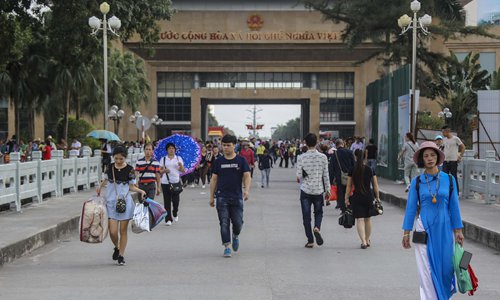HOME >> SOURCE
Trade war speeds up China-Vietnam economic interaction
Source:Global Times Published: 2020/1/1 21:48:40

Visitors and residents from China and Vietnam cross the two countries' border in Fangchenggang, South China's Guangxi Zhuang Autonomous Region on December 3, 2018. Photo:VCG
It seems that the trade war has sped up the economic interaction between China and Vietnam along the border. Much has been discussed as to how the Vietnamese economy has benefited from the manufacturing shift from China, but few would know that China has also gained from Vietnam's rise.Despite the global economic slowdown in general, Vietnam's GDP expanded 7.02 percent in 2019, marking the second consecutive year for its economic growth to surpass 7 percent since 2011, according to Vietnam's General Statistics Office.
To a certain extent, the Southeast Asian country's strong economic performance could be attributed to Chinese manufacturing companies' moving out of China to evade tariffs or tariff threats from the US as reflected by the robust expansion of Vietnam's processing and manufacturing sector, which rose 11.29 percent last year, the highest level in seven years.
While the development in Vietnam may seem to indicate an unfavorable situation for China at first glance, it somehow offers a boost to the construction and development of the Beibu Gulf economic zone in South China's Guangxi Zhuang Autonomous Region.
China's central government has attached great importance to the coastal and border areas of Guangxi by approving the Beibu Gulf economic zone - which is composed of cities like Beihai, Qinzhou and Fangchenggang - as the frontier of opening-up to the Association of Southeast Asian Nations. According to the central government's planning, the Beibu Gulf area will become a special economic zone similar to the Guangdong-Hong Kong-Macao Greater Bay Area.
And now the economic rise in Vietnam has brought external stimulation to the development of the economic zone. Thanks to the manufacturing shift over the years, the Vietnamese economy has grew at a fast pace, contributing not only to its trade with the US due to the trade war, but also to the trade with its neighboring countries like China.
Take Chongzuo, a city in the Beibu Gulf area, as an example. Located on the China-Vietnam borderline, Chongzuo's foreign trade volume has ranked first in Guangxi for 10 consecutive years by 2018. In the first half of last year, the foreign trade volume through Pingxiang, a county-level city under the administration of Chongzuo, surged by a record 59.5 percent to 54.5 billion yuan.
In this sense, Vietnam's development is mainly positive for China, despite the competition in some low-end manufacturing sectors.
In fact, such a positive effect is not just limited to Vietnam. The manufacturing rise in Southeast Asian countries like Thailand and Laos will also in turn promote the development in China's border areas.
That may be one of the reasons why the trade war has seen China grow even faster. A partial shift of manufacturing from China has led to the development of its neighboring countries like Vietnam, which are actually closely related to the Chinese economy, and thus has also lifted the economy in China's border areas.
Posted in: GT VOICE